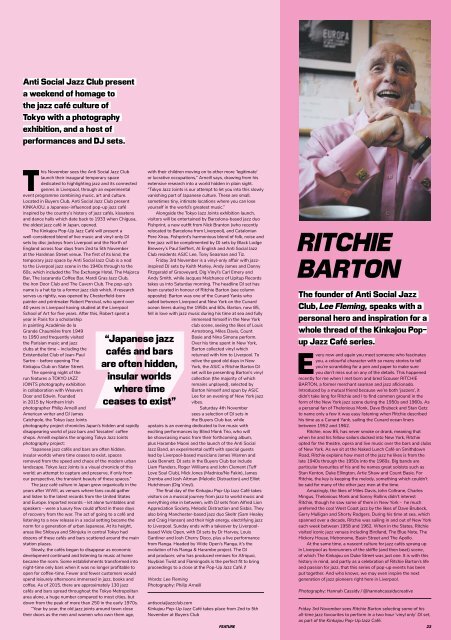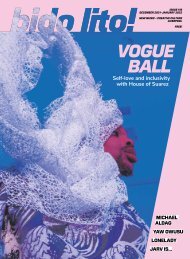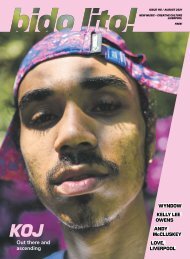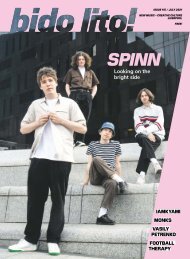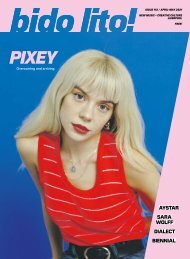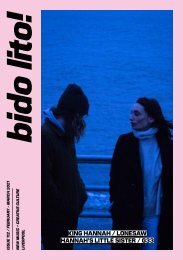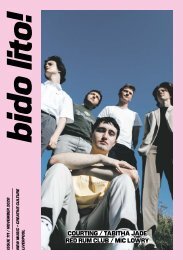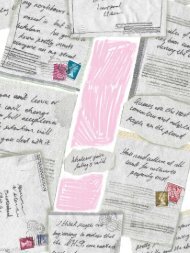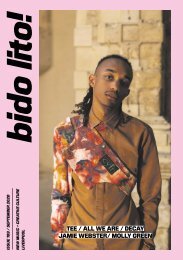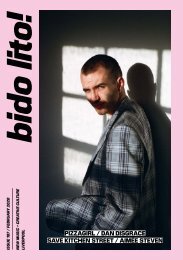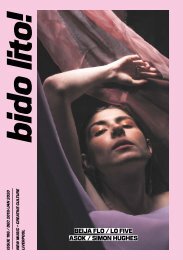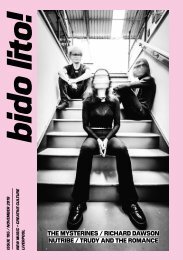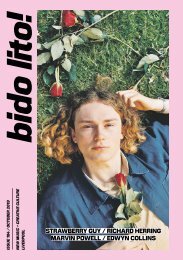Issue 83 / November 2017
November 2017 issue of Bido Lito! magazine. Featuring: SILENT BILL, SECRET SOCIETY OF SUPERVILLIAN ARTISTS, XAMVOLO, REMÉE, MERSEYRAIL SOUND STATION, HOWIE PAYNE, LOYLE CARNER, LIVERPOOL PSYCH FEST, ZOLA JESUS and much more.
November 2017 issue of Bido Lito! magazine. Featuring: SILENT BILL, SECRET SOCIETY OF SUPERVILLIAN ARTISTS, XAMVOLO, REMÉE, MERSEYRAIL SOUND STATION, HOWIE PAYNE, LOYLE CARNER, LIVERPOOL PSYCH FEST, ZOLA JESUS and much more.
You also want an ePaper? Increase the reach of your titles
YUMPU automatically turns print PDFs into web optimized ePapers that Google loves.
Anti Social Jazz Club present<br />
a weekend of homage to<br />
the jazz café culture of<br />
Tokyo with a photography<br />
exhibition, and a host of<br />
performances and DJ sets.<br />
This <strong>November</strong> sees the Anti Social Jazz Club<br />
launch their inaugural temporary space<br />
dedicated to highlighting jazz and its connected<br />
genres in Liverpool, through an experimental<br />
event programme combining music, art and culture.<br />
Located in Buyers Club, Anti Social Jazz Club present<br />
KINKAJOU, a Japanese-influenced pop-up jazz café<br />
inspired by the country’s history of jazz cafés, kissatens<br />
and dance halls which date back to 1933 when Chigusa,<br />
the oldest jazz café in Japan, opened.<br />
The Kinkajou Pop-Up Jazz Café will present a<br />
well-considered blend of live music and vinyl-only DJ<br />
sets by disc jockeys from Liverpool and the North of<br />
England across four days from 2nd to 5th <strong>November</strong><br />
at the Hardman Street venue. The first of its kind, the<br />
temporary jazz space by Anti Social Jazz Club is a nod<br />
to the Liverpool jazz scene in the 1940s through to the<br />
60s, which included the The Exchange Hotel, The Majorca<br />
Bar, The Jacaranda Coffee Bar, Mardi Gras Jazz Club,<br />
the Iron Door Club and The Cavern Club. The pop-up’s<br />
name is a hat tip to a former jazz club which, if research<br />
serves us rightly, was opened by Chesterfield-born<br />
painter and printmaker Robert Percival, who spent over<br />
40 years in Liverpool having studied at the Liverpool<br />
School of Art for five years. After this, Robert spent a<br />
year in Paris for a scholarship<br />
in painting Académie de la<br />
Grande Chaumière from 1949<br />
“Japanese jazz<br />
cafés and bars<br />
are often hidden,<br />
insular worlds<br />
where time<br />
ceases to exist”<br />
to 1950 and frequently visited<br />
the Parisian music and jazz<br />
clubs at the time – including the<br />
Existentialist Club of Jean-Paul<br />
Sartre – before opening The<br />
Kinkajou Club on Slater Street.<br />
The opening night of the<br />
run features a TOKYO JAZZ<br />
JOINTS photography exhibition<br />
in collaboration with Weavers<br />
Door and Edwin. Founded<br />
in 2015 by Northern Irish<br />
photographer Philip Arneill and<br />
American writer and DJ James<br />
Catchpole, the Tokyo Jazz Joints<br />
photography project chronicles Japan’s hidden and rapidly<br />
disappearing world of jazz bars and ‘kissaten’ coffee<br />
shops. Arneill explains the ongoing Tokyo Jazz Joints<br />
photography project:<br />
“Japanese jazz cafés and bars are often hidden,<br />
insular worlds where time ceases to exist, spaces<br />
removed from the speed and chaos of the modern urban<br />
landscape. Tokyo Jazz Joints is a visual chronicle of this<br />
world; an attempt to capture and preserve, if only from<br />
our perspective, the transient beauty of these spaces.”<br />
The jazz café culture in Japan grew organically in the<br />
years after WWII, as venues where fans could gather<br />
and listen to the latest records from the United States<br />
and Europe. Imported records – let alone turntables and<br />
speakers – were a luxury few could afford in those days<br />
of recovery from the war. The act of going to a café and<br />
listening to a new release in a social setting became the<br />
norm for a generation of urban Japanese. At its height,<br />
areas like Shibuya and Shinjuku in central Tokyo had<br />
dozens of these cafés and bars scattered around the main<br />
station plazas.<br />
Slowly, the cafés began to disappear as economic<br />
development continued and listening to music at home<br />
became the norm. Some establishments transformed into<br />
night-time only bars when it was no longer profitable to<br />
open for coffee-time. Fewer and fewer customers would<br />
spend leisurely afternoons immersed in jazz, books and<br />
coffee. As of 2015, there are approximately 130 jazz<br />
cafés and bars spread throughout the Tokyo Metropolitan<br />
area alone, a huge number compared to most cities, but<br />
down from the peak of more than 250 in the early 1970s.<br />
“Year by year, the old jazz joints around town close<br />
their doors as the men and women who own them age,<br />
with their children moving on to other more ‘legitimate’<br />
or lucrative occupations,” Arneill says, drawing from his<br />
extensive research into a world hidden in plain sight.<br />
“Tokyo Jazz Joints is our attempt to let you into this slowly<br />
vanishing part of Japanese culture. These are small,<br />
sometimes tiny, intimate locations where you can lose<br />
yourself in the world’s greatest music.”<br />
Alongside the Tokyo Jazz Joints exhibition launch,<br />
visitors will be entertained by Barcelona-based jazz duo<br />
Fishprint, a new outfit from Nick Branton (who recently<br />
relocated to Barcelona from Liverpool), and Catalonian<br />
Pere Xirau. Fishprint’s harmonious blend of folk, noise and<br />
free jazz will be complimented by DJ sets by Black Lodge<br />
Brewery’s Paul Seiffert, Al English and Anti Social Jazz<br />
Club residents ASJC Lee, Tony Seasman and Tiz.<br />
Friday 3rd <strong>November</strong> is a vinyl-only affair with jazzinspired<br />
DJ sets by Keith Marley, Andy James and Danny<br />
Fitzgerald of Grooveyard, Dig Vinyl’s Carl Emery and<br />
Andy Smith, while Jacques Malchance of Upitup Records<br />
takes us into Saturday morning. The headline DJ set has<br />
been curated in honour of Ritchie Barton (see column<br />
opposite): Barton was one of the Cunard Yanks who<br />
sailed between Liverpool and New York on the Cunard<br />
ocean liners during the 1950s and 60s. Barton, now 85,<br />
fell in love with jazz music during his time at sea and fully<br />
immersed himself in the New York<br />
club scene, seeing the likes of Louis<br />
Armstrong, Miles Davis, Count<br />
Basie and Nina Simone perform.<br />
Over his time spent in New York,<br />
Barton collected vinyl which<br />
returned with him to Liverpool. To<br />
relive the good old days in New<br />
York, the ASJC x Ritchie Barton DJ<br />
set will be presenting Barton’s vinyl<br />
collection (the majority of which<br />
remains unplayed), selected by<br />
Barton himself and spun by ASJC<br />
Lee for an evening of New York jazz<br />
vibes.<br />
Saturday 4th <strong>November</strong><br />
sees a selection of DJ sets in<br />
the Buyers Club bar, while<br />
upstairs is an evening dedicated to live music with<br />
exciting performances by Blind Monk Trio, who will<br />
be showcasing music from their forthcoming album,<br />
plus Harambe Maoni and the launch of the Anti Social<br />
Jazz Band, an experimental outfit with special guests<br />
lead by Liverpool-based musicians James Warren and<br />
Luke Bennett. DJ sets in the Buyers Club bar include<br />
Liam Flanders, Roger Williams and John Clement (Tuff<br />
Love Soul Club), Mick Jones (Madnice/No Fakin), James<br />
Zremba and Josh Aitman (Melodic Distraction) and Elliot<br />
Hutchinson (Dig Vinyl).<br />
The final day of the Kinkajou Pop-Up Jazz Café takes<br />
visitors on a musical journey from jazz to world music and<br />
everything else in between, with DJ sets from Alfred Lion<br />
Appreciation Society, Melodic Distraction and Sisbis. They<br />
also bring Manchester-based jazz duo Skeltr (Sam Healey<br />
and Craig Hanson) and their high energy, electrifying jazz<br />
to Liverpool. Sunday ends with a takeover by Liverpoolbased<br />
Wide Open, with DJ sets by Dr Harvey, Louis<br />
Gardiner and Josh Cherry Disco, plus a live performance<br />
from Ranga. Headed by Wide Open’s Ranga, it’s the<br />
evolution of his Ranga & Harambe project. The DJ<br />
and producer, who has produced remixes for Afriquoi,<br />
Nuybian Twist and Flamingods is the perfect fit to bring<br />
proceedings to a close at the Pop-Up Jazz Café. !<br />
Words: Lee Fleming<br />
Photography: Philip Arneill<br />
antisocialjazzclub.com<br />
Kinkajou Pop-Up Jazz Café takes place from 2nd to 5th<br />
<strong>November</strong> at Buyers Club<br />
FEATURE<br />
RITCHIE<br />
BARTON<br />
The founder of Anti Social Jazz<br />
Club, Lee Fleming, speaks with a<br />
personal hero and inspiration for a<br />
whole thread of the Kinkajou Popup<br />
Jazz Café series.<br />
Every now and again you meet someone who fascinates<br />
you, a colourful character with so many stories to tell<br />
you’re scrambling for a pen and paper to make sure<br />
you don’t miss out on any of the details. This happened<br />
recently for me when I met born and bred Scouser RITCHIE<br />
BARTON, a former merchant seaman and jazz aficionado.<br />
Introduced by a mutual friend because we’re both ‘jazzers’, it<br />
didn’t take long for Ritchie and I to find common ground in the<br />
form of the New York jazz scene during the 1950s and 1960s. As<br />
a personal fan of Thelonious Monk, Dave Brubeck and Stan Getz<br />
to name only a few it was easy listening when Ritchie described<br />
his time as a Cunard Yank, sailing the Cunard ocean liners<br />
between 1952 and 1962.<br />
Ritchie, now 85, has never smoke or drank, meaning that<br />
when he and his fellow sailors docked into New York, Ritchie<br />
opted for the theatre, opera and live music over the bars and clubs<br />
of New York. As we sit at the Naked Lunch Café on Smithdown<br />
Road, Ritchie explains how most of the jazz he likes is from the<br />
late 1940s through the 1950s into the 1960s. Big bands are<br />
particular favourites of his and he names great soloists such as<br />
Stan Kenton, Duke Ellington, Artie Shaw and Count Basie. For<br />
Ritchie, the key is keeping the melody, something which couldn’t<br />
be said for many of the other jazz men at the time.<br />
Amazingly, the likes of Miles Davis, John Coltrane, Charles<br />
Mingus, Thelonious Monk and Sonny Rollins didn’t interest<br />
Ritchie, though he saw some of them in New York – he much<br />
preferred the cool West Coast jazz by the likes of Dave Brubeck,<br />
Gerry Mulligan and Shorty Rodgers. During his time at sea, which<br />
spanned over a decade, Ritchie was sailing in and out of New York<br />
each week between 1958 and 1962. When in the States, Ritchie<br />
visited iconic jazz venues including Birdland, The Blue Note, The<br />
Hickory House, Metronome, Basin Street and The Apollo.<br />
At the same time, a nascent culture for jazz cafés sprang up<br />
in Liverpool as forerunners of the skiffle (and then beat) scene,<br />
of which The Kinkajou on Duke Street was just one. It is with this<br />
history in mind, and partly as a celebration of Ritchie Barton’s life<br />
and passion for jazz, that this series of pop-up events has been<br />
put together. And who knows, we may even inspire the next<br />
generation of jazz pioneers right here in Liverpool.<br />
Photography: Hannah Cassidy / @hannahcassidycreative<br />
Friday 3rd <strong>November</strong> sees Ritchie Barton selecting some of his<br />
all-time jazz favourites to perform in a two hour ‘vinyl only’ DJ set,<br />
as part of the Kinkajou Pop-Up Jazz Café.<br />
23


